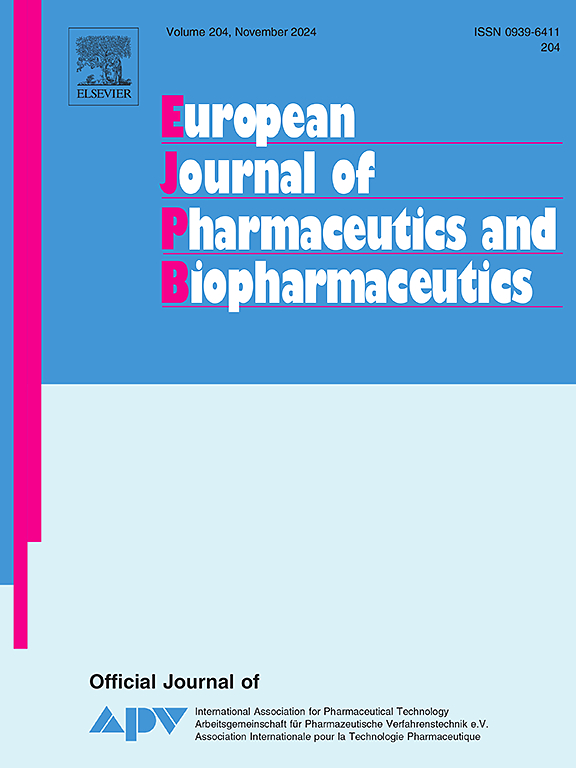Predicting the solubility of drugs in supercritical carbon dioxide using machine learning and atomic contribution
IF 4.4
2区 医学
Q1 PHARMACOLOGY & PHARMACY
European Journal of Pharmaceutics and Biopharmaceutics
Pub Date : 2025-04-16
DOI:10.1016/j.ejpb.2025.114720
引用次数: 0
Abstract
The pharmaceutical sector is aware of supercritical CO2 (SC-CO2) as a possible replacement for problematic organic solvents. Using a novel artificial intelligence (AI) strategy to predict drug solubility using the SC-CO2 system mathematically has been deemed an intriguing approach. In this work, the atomic contribution (AC) method and machine learning (ML) models are combined to develop hybrid machine learning models to compute the solubility of several drugs, including anticoagulants, anti-cancers, calcium channel blockers, immunosuppressives, antihistamines, and others. The novelty of the approach lies in using the AC concept to capture molecular details at the atomic level. This enables the model to account for the specific contributions of individual atoms and to provide more precise input features for machine learning. The integration of these molecular insights with ML techniques results in significantly improved predictive performance over traditional ML methods. Throughout the modeling procedure, temperature, pressure, the density of SC-CO2, and the effect of constituent atoms of the drugs are the input variables, while the solubility of drugs is the output. This study looks into predicting the solubility of these drugs in SC-CO2 using the least square support vector machine (LSSVM) with radial basis function kernel (RBF) and multilayer perceptron artificial neural network (MLPANN). These models were developed using a database including 2358 experimental solubility data points from 86 solid drugs. The solubility of solid drugs in supercritical CO2 spans a remarkably wide range in this study, from as high as 3.9 × 10-2 to as low as 1 × 10-7. The results demonstrated that this innovative approach could estimate solid drug solubility in SC-CO2 with AARD% and R2 values of 7.20 and 0.99, respectively, under different pressure and temperature conditions. The ability of the models to capture a wide range of solubilities in SC-CO2 showcases their effectiveness in dealing with both highly and poorly soluble compounds. The developed models, considering their global prediction, accuracy, and being user-friendly, are the best options to be used by researchers for incorporating into software for enabling more efficient design of supercritical extraction processes and reducing the need for trial-and-error experimentation in manufacturing.

利用机器学习和原子贡献预测药物在超临界二氧化碳中的溶解度
制药部门意识到超临界二氧化碳(SC-CO2)作为有问题的有机溶剂的可能替代品。使用一种新的人工智能(AI)策略来预测使用SC-CO2系统的药物溶解度的数学方法被认为是一种有趣的方法。在这项工作中,原子贡献(AC)方法和机器学习(ML)模型相结合,开发混合机器学习模型来计算几种药物的溶解度,包括抗凝血剂、抗癌药物、钙通道阻滞剂、免疫抑制剂、抗组胺药等。该方法的新颖之处在于使用AC概念在原子水平上捕捉分子细节。这使得模型能够解释单个原子的具体贡献,并为机器学习提供更精确的输入特征。与传统的机器学习方法相比,这些分子洞察与机器学习技术的集成显著提高了预测性能。在整个建模过程中,温度、压力、SC-CO2的密度以及药物组成原子的影响是输入变量,而药物的溶解度是输出变量。本研究利用径向基函数核(RBF)最小二乘支持向量机(LSSVM)和多层感知器人工神经网络(MLPANN)预测这些药物在SC-CO2中的溶解度。这些模型是用一个包含86种固体药物2358个实验溶解度数据点的数据库建立的。本研究中固体药物在超临界CO2中的溶解度范围非常广,从高达3.9 × 10-2到低至1 × 10-7。结果表明,在不同的压力和温度条件下,该方法可以估计出SC-CO2中的固体药物溶解度,其AARD%和R2分别为7.20和0.99。这些模型能够捕获SC-CO2中广泛的溶解度,这表明它们在处理高溶性和低溶性化合物方面都是有效的。考虑到其全局预测、准确性和用户友好性,开发的模型是研究人员用于将其纳入软件的最佳选择,以实现更有效的超临界萃取过程设计,并减少制造过程中反复试验的需要。
本文章由计算机程序翻译,如有差异,请以英文原文为准。
求助全文
约1分钟内获得全文
求助全文
来源期刊
CiteScore
8.80
自引率
4.10%
发文量
211
审稿时长
36 days
期刊介绍:
The European Journal of Pharmaceutics and Biopharmaceutics provides a medium for the publication of novel, innovative and hypothesis-driven research from the areas of Pharmaceutics and Biopharmaceutics.
Topics covered include for example:
Design and development of drug delivery systems for pharmaceuticals and biopharmaceuticals (small molecules, proteins, nucleic acids)
Aspects of manufacturing process design
Biomedical aspects of drug product design
Strategies and formulations for controlled drug transport across biological barriers
Physicochemical aspects of drug product development
Novel excipients for drug product design
Drug delivery and controlled release systems for systemic and local applications
Nanomaterials for therapeutic and diagnostic purposes
Advanced therapy medicinal products
Medical devices supporting a distinct pharmacological effect.

 求助内容:
求助内容: 应助结果提醒方式:
应助结果提醒方式:


